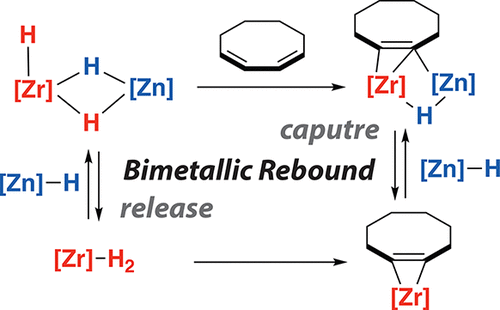当前位置:
X-MOL 学术
›
Organometallics
›
论文详情
Our official English website, www.x-mol.net, welcomes your
feedback! (Note: you will need to create a separate account there.)
Heterobimetallic Rebound: A Mechanism for Diene-to-Alkyne Isomerization with M---Zr Hydride Complexes (M = Al, Zn, and Mg)
Organometallics ( IF 2.5 ) Pub Date : 2018-02-28 00:00:00 , DOI: 10.1021/acs.organomet.7b00908 M. J. Butler 1 , A. J. P. White 1 , M. R. Crimmin 1
Organometallics ( IF 2.5 ) Pub Date : 2018-02-28 00:00:00 , DOI: 10.1021/acs.organomet.7b00908 M. J. Butler 1 , A. J. P. White 1 , M. R. Crimmin 1
Affiliation

|
The reaction of a series of M·Zr heterobimetallic hydride complexes with dienes and alkynes has been investigated (M = Al, Zn, and Mg). Reaction of M·Zr with 1,5-cyclooctadiene led to diene isomerization to 1,3-cyclooctadiene, but for M = Zn also result in an on-metal diene-to-alkyne isomerization. The resulting cyclooctyne fragment is trapped between Zr and Zn metals in a heterobimetallic species that does not form for M = Mg or Al. The scope of diene isomerization and alkyne trapping has been explored leading to the isolation of three new heterobimetallic slipped metallocyclopropene complexes. The mechanism of diene-to-alkyne isomerization was investigated through kinetics. While the reaction is first-order in Zn·Zr at high diene concentration and proceeds with ΔH‡ = +33.6 ± 0.7 kcal mol–1, ΔS‡ = +23.2 ± 1.7 cal mol–1 K–1, and ΔG⧧298 K = +26.7 ± 1.2 kcal mol–1, the rate is dependent on the nature of the diene. The positive activation entropy is suggestive of involvement of a dissociative step. On the basis of DFT calculations, a heterobimetallic rebound mechanism for diene-to-alkyne isomerization has been proposed. This mechanism explains the origin of heterobimetallic control over selectivity: Mg---Zr complexes are too strongly bound to generate reactive fragments, while Al---Zr complexes are too weakly bound to compensate for the contrathermodynamic isomerization process. Zn---Zr complexes have favorable energetics for both dissociation and trapping steps.
中文翻译:

异双金属回弹:M --- Zr氢化物配合物(M = Al,Zn和Mg)的二烯至炔烃异构化的机理
研究了一系列M · Zr杂双金属氢化物与二烯和炔烃的反应(M = Al,Zn和Mg)。的反应中号·锆与导致二烯异构化为1,3-环辛二烯1,5-环辛二烯,但对于M =锌也导致对金属二烯到炔异构化。生成的环辛炔片段被困在Zr和Zn金属之间,形成的杂双金属物种对于M = Mg或Al不会形成。已经探索了二烯异构化和炔烃捕集的范围,从而导致了三种新的异双金属滑环金属环丙烯络合物的分离。通过动力学研究了二烯到炔烃异构化的机理。在Zn·Zr中反应是一阶的在高浓度的二烯,并进入与Δ ħ ‡ = 33.6±0.7千卡摩尔-1,Δ小号‡ = 23.2±1.7摩尔CAL -1 ķ -1,Δ ģ ⧧ ,298K = 26.7±1.2千卡摩尔- 1个,速率取决于二烯的性质。正激活熵提示涉及解离步骤。在DFT计算的基础上,提出了一种用于双烯-炔异构化的异双金属回弹机理。这种机制解释了异双金属控制选择性的起源:Mg --- Zr络合物的结合太牢固而无法生成反应性片段,而Al --- Zr络合物的结合太弱而无法补偿对流动力学异构化过程。Zn--Zr配合物在离解和捕获步骤中都具有良好的能量学性质。
更新日期:2018-02-28
中文翻译:

异双金属回弹:M --- Zr氢化物配合物(M = Al,Zn和Mg)的二烯至炔烃异构化的机理
研究了一系列M · Zr杂双金属氢化物与二烯和炔烃的反应(M = Al,Zn和Mg)。的反应中号·锆与导致二烯异构化为1,3-环辛二烯1,5-环辛二烯,但对于M =锌也导致对金属二烯到炔异构化。生成的环辛炔片段被困在Zr和Zn金属之间,形成的杂双金属物种对于M = Mg或Al不会形成。已经探索了二烯异构化和炔烃捕集的范围,从而导致了三种新的异双金属滑环金属环丙烯络合物的分离。通过动力学研究了二烯到炔烃异构化的机理。在Zn·Zr中反应是一阶的在高浓度的二烯,并进入与Δ ħ ‡ = 33.6±0.7千卡摩尔-1,Δ小号‡ = 23.2±1.7摩尔CAL -1 ķ -1,Δ ģ ⧧ ,298K = 26.7±1.2千卡摩尔- 1个,速率取决于二烯的性质。正激活熵提示涉及解离步骤。在DFT计算的基础上,提出了一种用于双烯-炔异构化的异双金属回弹机理。这种机制解释了异双金属控制选择性的起源:Mg --- Zr络合物的结合太牢固而无法生成反应性片段,而Al --- Zr络合物的结合太弱而无法补偿对流动力学异构化过程。Zn--Zr配合物在离解和捕获步骤中都具有良好的能量学性质。










































 京公网安备 11010802027423号
京公网安备 11010802027423号